Long-Term Memory Function Impairments following Sucrose Exposure in Juvenile versus Adult Rats
Abstract
1. Introduction
2. Materials and Methods
2.1. Experimental Animals
2.2. Triglycerides and Corticosterone Serum Levels
2.3. Glucose Tolerance Test
2.4. Novel Object Recognition Task
2.5. Western Blot
2.6. Statistical Analysis
3. Results
3.1. Long-term Effects of Sucrose Exposure on Learning
3.2. Short- and Long-term Effects of Sucrose Exposure on Glucose Tolerance Test and Serum Levels of BG, TG, and Corticosterone
3.3. Long-Term Effects of Sucrose on RAGE Expression
3.4. Long-Term Effects of Sucrose on proBDNF Expression
4. Discussion
5. Conclusions
Author Contributions
Funding
Institutional Review Board Statement
Data Availability Statement
Acknowledgments
Conflicts of Interest
References
- Tappy, L. Q&A: ‘toxic’ effects of sugar: Should we be afraid of fructose? BMC Biol. 2012, 10, 42. [Google Scholar] [CrossRef]
- Rippe, J.M.; Angelopoulos, T.J. Added sugars and risk factors for obesity, diabetes and heart disease. Int. J. Obes. 2016, 40 (Suppl. 1), S22–S27. [Google Scholar] [CrossRef] [PubMed]
- Yang, Q.; Zhang, Z.; Gregg, E.W.; Flanders, W.D.; Merritt, R.; Hu, F.B. Added sugar intake and cardiovascular diseases mortality among US adults. JAMA Intern. Med. 2014, 174, 516–524. [Google Scholar] [CrossRef] [PubMed]
- Malik, V.S.; Hu, F.B. Sweeteners and Risk of Obesity and Type 2 Diabetes: The Role of Sugar-Sweetened Beverages. Curr. Diabetes Rep. 2012, 12, 195–203. [Google Scholar] [CrossRef] [PubMed]
- Imamura, F.; O’Connor, L.; Ye, Z.; Mursu, J.; Hayashino, Y.; Bhupathiraju, S.N.; Forouhi, N.G. Consumption of sugar sweetened beverages, artificially sweetened beverages, and fruit juice and incidence of type 2 diabetes: Systematic review, meta-analysis, and estimation of population attributable fraction. BMJ 2015, 351, h3576. [Google Scholar] [CrossRef]
- de Koning, L.; Malik, V.S.; Kellogg, M.D.; Rimm, E.B.; Willett, W.C.; Hu, F.B. Sweetened beverage consumption, incident coronary heart disease, and biomarkers of risk in men. Circulation 2012, 125, 1735–1741, S1731. [Google Scholar] [CrossRef]
- Kruse, M.S.; Vadillo, M.J.; Miguelez Fernandez, A.M.M.; Rey, M.; Zanutto, B.S.; Coirini, H. Sucrose exposure in juvenile rats produces long-term changes in fear memory and anxiety-like behavior. Psychoneuroendocrinology 2019, 104, 300–307. [Google Scholar] [CrossRef]
- Beilharz, J.E.; Maniam, J.; Morris, M.J. Short-term exposure to a diet high in fat and sugar, or liquid sugar, selectively impairs hippocampal-dependent memory, with differential impacts on inflammation. Behav. Brain Res. 2016, 306, 1–7. [Google Scholar] [CrossRef]
- Reichelt, A.C.; Killcross, S.; Hambly, L.D.; Morris, M.J.; Westbrook, R.F. Impact of adolescent sucrose access on cognitive control, recognition memory, and parvalbumin immunoreactivity. Learn. Mem. 2015, 22, 215–224. [Google Scholar] [CrossRef]
- Hsu, T.M.; Konanur, V.R.; Taing, L.; Usui, R.; Kayser, B.D.; Goran, M.I.; Kanoski, S.E. Effects of sucrose and high fructose corn syrup consumption on spatial memory function and hippocampal neuroinflammation in adolescent rats. Hippocampus 2015, 25, 227–239. [Google Scholar] [CrossRef]
- van der Borght, K.; Kohnke, R.; Goransson, N.; Deierborg, T.; Brundin, P.; Erlanson-Albertsson, C.; Lindqvist, A. Reduced neurogenesis in the rat hippocampus following high fructose consumption. Regul. Pept. 2011, 167, 26–30. [Google Scholar] [CrossRef]
- Calabrese, F.; Rossetti, A.C.; Racagni, G.; Gass, P.; Riva, M.A.; Molteni, R. Brain-derived neurotrophic factor: A bridge between inflammation and neuroplasticity. Front. Cell. Neurosci. 2014, 8, 430. [Google Scholar] [CrossRef] [PubMed]
- Murray, P.S.; Holmes, P.V. An overview of brain-derived neurotrophic factor and implications for excitotoxic vulnerability in the hippocampus. Int. J. Pept. 2011, 2011, 654085. [Google Scholar] [CrossRef] [PubMed]
- Bathina, S.; Das, U.N. Brain-derived neurotrophic factor and its clinical implications. Arch. Med. Sci. AMS 2015, 11, 1164–1178. [Google Scholar] [CrossRef] [PubMed]
- Barde, Y.A.; Edgar, D.; Thoenen, H. Purification of a new neurotrophic factor from mammalian brain. EMBO J. 1982, 1, 549–553. [Google Scholar] [CrossRef]
- Bozon, B.; Davis, S.; Laroche, S. A requirement for the immediate early gene zif268 in reconsolidation of recognition memory after retrieval. Neuron 2003, 40, 695–701. [Google Scholar] [CrossRef]
- Giacobbo, B.L.; de Freitas, B.S.; Vedovelli, K.; Schlemmer, L.M.; Pires, V.N.; Antoniazzi, V.; Santos, C.S.D.; Paludo, L.; Borges, J.V.; de Lima, D.B.; et al. Long-term environmental modifications affect BDNF concentrations in rat hippocampus, but not in serum. Behav. Brain Res. 2019, 372, 111965. [Google Scholar] [CrossRef]
- Kanarek, R.B.; Orthen-Gambill, N. Differential effects of sucrose, fructose and glucose on carbohydrate-induced obesity in rats. J. Nutr. 1982, 112, 1546–1554. [Google Scholar] [CrossRef]
- Lee, G.; Han, J.H.; Maeng, H.J.; Lim, S. Three-Month Daily Consumption of Sugar-Sweetened Beverages Affects the Liver, Adipose Tissue, and Glucose Metabolism. J. Obes. Metab. Syndr. 2020, 29, 26–38. [Google Scholar] [CrossRef]
- Lombardo, Y.B.; Drago, S.; Chicco, A.; Fainstein-Day, P.; Gutman, R.; Gagliardino, J.J.; Gomez Dumm, C.L. Long-term administration of a sucrose-rich diet to normal rats: Relationship between metabolic and hormonal profiles and morphological changes in the endocrine pancreas. Metab. Clin. Exp. 1996, 45, 1527–1532. [Google Scholar] [CrossRef]
- Pagliassotti, M.J.; Prach, P.A.; Koppenhafer, T.A.; Pan, D.A. Changes in insulin action, triglycerides, and lipid composition during sucrose feeding in rats. Am. J. Physiol. 1996, 271, R1319–R1326. [Google Scholar] [CrossRef] [PubMed]
- Bierhaus, A.; Schiekofer, S.; Schwaninger, M.; Andrassy, M.; Humpert, P.M.; Chen, J.; Hong, M.; Luther, T.; Henle, T.; Kloting, I.; et al. Diabetes-associated sustained activation of the transcription factor nuclear factor-kappaB. Diabetes 2001, 50, 2792–2808. [Google Scholar] [CrossRef]
- Soares, E.; Prediger, R.D.; Nunes, S.; Castro, A.A.; Viana, S.D.; Lemos, C.; De Souza, C.M.; Agostinho, P.; Cunha, R.A.; Carvalho, E.; et al. Spatial memory impairments in a prediabetic rat model. Neuroscience 2013, 250, 565–577. [Google Scholar] [CrossRef] [PubMed]
- Meireles, M.; Marques, C.; Norberto, S.; Fernandes, I.; Mateus, N.; Rendeiro, C.; Spencer, J.P.; Faria, A.; Calhau, C. The impact of chronic blackberry intake on the neuroinflammatory status of rats fed a standard or high-fat diet. J. Nutr. Biochem. 2015, 26, 1166–1173. [Google Scholar] [CrossRef] [PubMed]
- Bettiga, A.; Fiorio, F.; Di Marco, F.; Trevisani, F.; Romani, A.; Porrini, E.; Salonia, A.; Montorsi, F.; Vago, R. The Modern Western Diet Rich in Advanced Glycation End-Products (AGEs): An Overview of Its Impact on Obesity and Early Progression of Renal Pathology. Nutrients 2019, 11, 1748. [Google Scholar] [CrossRef] [PubMed]
- Giacco, F.; Brownlee, M. Oxidative stress and diabetic complications. Circ. Res. 2010, 107, 1058–1070. [Google Scholar] [CrossRef]
- Srikanth, V.; Maczurek, A.; Phan, T.; Steele, M.; Westcott, B.; Juskiw, D.; Munch, G. Advanced glycation endproducts and their receptor RAGE in Alzheimer’s disease. Neurobiol. Aging 2011, 32, 763–777. [Google Scholar] [CrossRef]
- Huang, M.; Que, Y.; Shen, X. Correlation of the plasma levels of soluble RAGE and endogenous secretory RAGE with oxidative stress in pre-diabetic patients. J. Diabetes Its Complicat. 2015, 29, 422–426. [Google Scholar] [CrossRef]
- Chandna, A.R.; Kuhlmann, N.; Bryce, C.A.; Greba, Q.; Campanucci, V.A.; Howland, J.G. Chronic maternal hyperglycemia induced during mid-pregnancy in rats increases RAGE expression, augments hippocampal excitability, and alters behavior of the offspring. Neuroscience 2015, 303, 241–260. [Google Scholar] [CrossRef]
- Sanguesa, G.; Cascales, M.; Grinan, C.; Sanchez, R.M.; Roglans, N.; Pallas, M.; Laguna, J.C.; Alegret, M. Impairment of Novel Object Recognition Memory and Brain Insulin Signaling in Fructose- but Not Glucose-Drinking Female Rats. Mol. Neurobiol. 2018, 55, 6984–6999. [Google Scholar] [CrossRef]
- Momeni, Z.; Bautista, M.; Neapetung, J.; Urban, R.; Yamamoto, Y.; Krishnan, A.; Campanucci, V.A. RAGE signaling is required for AMPA receptor dysfunction in the hippocampus of hyperglycemic mice. Physiol. Behav. 2021, 229, 113255. [Google Scholar] [CrossRef]
- Abbott, K.N.; Morris, M.J.; Westbrook, R.F.; Reichelt, A.C. Sex-specific effects of daily exposure to sucrose on spatial memory performance in male and female rats, and implications for estrous cycle stage. Physiol. Behav. 2016, 162, 52–60. [Google Scholar] [CrossRef] [PubMed]
- Xu, T.J.; Reichelt, A.C. Sucrose or sucrose and caffeine differentially impact memory and anxiety-like behaviours, and alter hippocampal parvalbumin and doublecortin. Neuropharmacology 2018, 137, 24–32. [Google Scholar] [CrossRef]
- Dix, S.L.; Aggleton, J.P. Extending the spontaneous preference test of recognition: Evidence of object-location and object-context recognition. Behav. Brain Res. 1999, 99, 191–200. [Google Scholar] [CrossRef]
- Winters, B.D.; Forwood, S.E.; Cowell, R.A.; Saksida, L.M.; Bussey, T.J. Double dissociation between the effects of peri-postrhinal cortex and hippocampal lesions on tests of object recognition and spatial memory: Heterogeneity of function within the temporal lobe. J. Neurosci. Off. J. Soc. Neurosci. 2004, 24, 5901–5908. [Google Scholar] [CrossRef]
- Hammond, R.S.; Tull, L.E.; Stackman, R.W. On the delay-dependent involvement of the hippocampus in object recognition memory. Neurobiol. Learn. Mem. 2004, 82, 26–34. [Google Scholar] [CrossRef] [PubMed]
- Jurdak, N.; Kanarek, R.B. Sucrose-induced obesity impairs novel object recognition learning in young rats. Physiol. Behav. 2009, 96, 1–5. [Google Scholar] [CrossRef]
- Buyukata, C.; Vukalo, M.; Xu, T.J.; Khore, M.A.; Reichelt, A.C. Impact of high sucrose diets on the discrimination of spatial and object memories with overlapping features. Physiol. Behav. 2018, 192, 127–133. [Google Scholar] [CrossRef]
- Beilharz, J.E.; Maniam, J.; Morris, M.J. Short exposure to a diet rich in both fat and sugar or sugar alone impairs place, but not object recognition memory in rats. Brain Behav. Immun. 2014, 37, 134–141. [Google Scholar] [CrossRef]
- Wong, A.; Dogra, V.R.; Reichelt, A.C. High-sucrose diets in male rats disrupt aspects of decision making tasks, motivation and spatial memory, but not impulsivity measured by operant delay-discounting. Behav. Brain Res. 2017, 327, 144–154. [Google Scholar] [CrossRef]
- Noble, E.E.; Hsu, T.M.; Liang, J.; Kanoski, S.E. Early-life sugar consumption has long-term negative effects on memory function in male rats. Nutr. Neurosci. 2019, 22, 273–283. [Google Scholar] [CrossRef] [PubMed]
- Guthrie, J.F.; Morton, J.F. Food sources of added sweeteners in the diets of Americans. J. Am. Diet. Assoc. 2000, 100, 43–51, quiz 49–50. [Google Scholar] [CrossRef]
- Frary, C.D.; Johnson, R.K.; Wang, M.Q. Children and adolescents’ choices of foods and beverages high in added sugars are associated with intakes of key nutrients and food groups. J. Adolesc. Health Off. Publ. Soc. Adolesc. Med. 2004, 34, 56–63. [Google Scholar] [CrossRef]
- Guelinckx, I.; Iglesia, I.; Bottin, J.H.; De Miguel-Etayo, P.; Gonzalez-Gil, E.M.; Salas-Salvado, J.; Kavouras, S.A.; Gandy, J.; Martinez, H.; Bardosono, S.; et al. Intake of water and beverages of children and adolescents in 13 countries. Eur. J. Nutr. 2015, 54 (Suppl. S2), 69–79. [Google Scholar] [CrossRef]
- Sisk, C.L.; Foster, D.L. The neural basis of puberty and adolescence. Nat. Neurosci. 2004, 7, 1040–1047. [Google Scholar] [CrossRef] [PubMed]
- Carmuega, E. Hidratación saludable en la infancia, 1st ed.; CESNI: CABA, Argentina, 2015. [Google Scholar]
- PAOH/WHO. Ultra-Processed Food and Drink Products in Latin America: Trends, Impact on Obesity, Policy Implications; PAHO, Ed.; Pan American Health Organization & World Health Organization: Washington, DC, USA, 2015; pp. 1–76. [Google Scholar]
- EMSE. 2° Encuesta Mundial de Salud Escolar (EMSE). Dirección de Promoción de la Salud y Control de Enfermedades No Transmisibles; Ministerio de Salud de la Nación: CABA, Argentina, 2012; pp. 1–110. [Google Scholar]
- ENNyS. 2° Encuesta Nacional de Nutrición y Salud (ENNyS). Ministerio de Salud y Desarrollo Social; Presidencia de la Nación: CABA, Argentina, 2019; pp. 1–78. [Google Scholar]
- Winters, B.D.; Saksida, L.M.; Bussey, T.J. Object recognition memory: Neurobiological mechanisms of encoding, consolidation and retrieval. Neurosci. Biobehav. Rev. 2008, 32, 1055–1070. [Google Scholar] [CrossRef]
- Cohen, S.J.; Stackman Jr, R.W. Assessing rodent hippocampal involvement in the novel object recognition task. A review. Behav. Brain Res. 2015, 285, 105–117. [Google Scholar] [CrossRef] [PubMed]
- Warburton, E.C.; Brown, M.W. Neural circuitry for rat recognition memory. Behav. Brain Res. 2015, 285, 131–139. [Google Scholar] [CrossRef] [PubMed]
- Barker, G.R.; Warburton, E.C. When is the hippocampus involved in recognition memory? J. Neurosci. Off. J. Soc. Neurosci. 2011, 31, 10721–10731. [Google Scholar] [CrossRef]
- Kruse, M.S.; Rey, M.; Vega, M.C.; Coirini, H. Alterations of LXRalpha and LXRbeta expression in the hypothalamus of glucose-intolerant rats. J. Endocrinol. 2012, 215, 51–58. [Google Scholar] [CrossRef]
- Rey, M.; Kruse, M.S.; Magrini-Huaman, R.N.; Coirini, H. High-Fat Diets and LXRs Expression in Rat Liver and Hypothalamus. Cell. Mol. Neurobiol. 2019, 39, 963–974. [Google Scholar] [CrossRef] [PubMed]
- Rey, M.; Kruse, M.S.; Magrini-Huaman, R.N.; Gomez, J.; Simirgiotis, M.J.; Tapia, A.; Feresin, G.E.; Coirini, H. Tessaria absinthioides (Hook. & Arn.) DC. (Asteraceae) Decoction Improves the Hypercholesterolemia and Alters the Expression of LXRs in Rat Liver and Hypothalamus. Metabolites 2021, 11, 579. [Google Scholar] [CrossRef] [PubMed]
- Perez-Garcia, G.; Guzman-Quevedo, O.; Da Silva Aragao, R.; Bolanos-Jimenez, F. Early malnutrition results in long-lasting impairments in pattern-separation for overlapping novel object and novel location memories and reduced hippocampal neurogenesis. Sci. Rep. 2016, 6, 21275. [Google Scholar] [CrossRef]
- Leger, M.; Quiedeville, A.; Bouet, V.; Haelewyn, B.; Boulouard, M.; Schumann-Bard, P.; Freret, T. Object recognition test in mice. Nat. Protoc. 2013, 8, 2531–2537. [Google Scholar] [CrossRef]
- Paxinos, G.; Watson, C.R.; Emson, P.C. AChE-stained horizontal sections of the rat brain in stereotaxic coordinates. J. Neurosci. Methods 1980, 3, 129–149. [Google Scholar] [CrossRef]
- Kruse, M.S.; Premont, J.; Krebs, M.O.; Jay, T.M. Interaction of dopamine D1 with NMDA NR1 receptors in rat prefrontal cortex. Eur. Neuropsychopharmacol. J. Eur. Coll. Neuropsychopharmacol. 2009, 19, 296–304. [Google Scholar] [CrossRef] [PubMed]
- Kruse, M.S.; Vega, M.C.; Rey, M.; Coirini, H. Sex differences in LXR expression in normal offspring and in rats born to diabetic dams. J. Endocrinol. 2014, 222, 53–60. [Google Scholar] [CrossRef] [PubMed]
- Kruse, M.S.; Suarez, L.G.; Coirini, H. LXR activation increases the expression of GnRH AND alphaMSH in the rat hypothalamus in vivo. Neurosci. Lett. 2018, 664, 20–27. [Google Scholar] [CrossRef] [PubMed]
- Kruse, M.S.; Suarez, L.G.; Coirini, H. Regulation of the expression of LXR in rat hypothalamic and hippocampal explants. Neurosci. Lett. 2017, 639, 53–58. [Google Scholar] [CrossRef] [PubMed]
- Gueye, A.B.; Vendruscolo, L.F.; de Avila, C.; Le Moine, C.; Darnaudery, M.; Cador, M. Unlimited sucrose consumption during adolescence generates a depressive-like phenotype in adulthood. Neuropsychopharmacol. Off. Publ. Am. Coll. Neuropsychopharmacol. 2018, 3, 2627–2635. [Google Scholar] [CrossRef] [PubMed]
- Jurdak, N.; Lichtenstein, A.H.; Kanarek, R.B. Diet-induced obesity and spatial cognition in young male rats. Nutr. Neurosci. 2008, 11, 48–54. [Google Scholar] [CrossRef] [PubMed]
- Reichelt, A.C.; Morris, M.J.; Westbrook, R.F. Daily access to sucrose impairs aspects of spatial memory tasks reliant on pattern separation and neural proliferation in rats. Learn. Mem. 2016, 23, 386–390. [Google Scholar] [CrossRef]
- Borodinova, A.A.; Salozhin, S.V. Diversity of proBDNF and mBDNF functions in the central nervous system. Zhurnal Vyss. Nervn. Deiatelnosti Im. IP Pavlov. 2016, 66, 3–23. [Google Scholar]
- Foltran, R.B.; Diaz, S.L. BDNF isoforms: A round trip ticket between neurogenesis and serotonin? J. Neurochem. 2016, 138, 204–221. [Google Scholar] [CrossRef] [PubMed]
- Vey, L.T.; Rosa, H.Z.; Barcelos, R.C.S.; Dias, V.T.; da Rocha, M.I.U.M.; Burger, M.E. Neonatal handling increases neurogenesis, BDNF and GR in the hippocampus favoring memory acquisition in rats. Brain Res. 2020, 1745, 146921. [Google Scholar] [CrossRef]
- An, L.; Li, X.; Tang, C.; Xu, N.; Sun, W. Hippocampal proBDNF facilitates place learning strategy associated with neural activity in rats. Brain Struct. Funct. 2018, 223, 4099–4113. [Google Scholar] [CrossRef] [PubMed]
- Silhol, M.; Arancibia, S.; Maurice, T.; Tapia-Arancibia, L. Spatial memory training modifies the expression of brain-derived neurotrophic factor tyrosine kinase receptors in young and aged rats. Neuroscience 2007, 146, 962–973. [Google Scholar] [CrossRef]
- Molteni, R.; Barnard, R.J.; Ying, Z.; Roberts, C.K.; Gomez-Pinilla, F. A high-fat, refined sugar diet reduces hippocampal brain-derived neurotrophic factor, neuronal plasticity, and learning. Neuroscience 2002, 112, 803–814. [Google Scholar] [CrossRef]


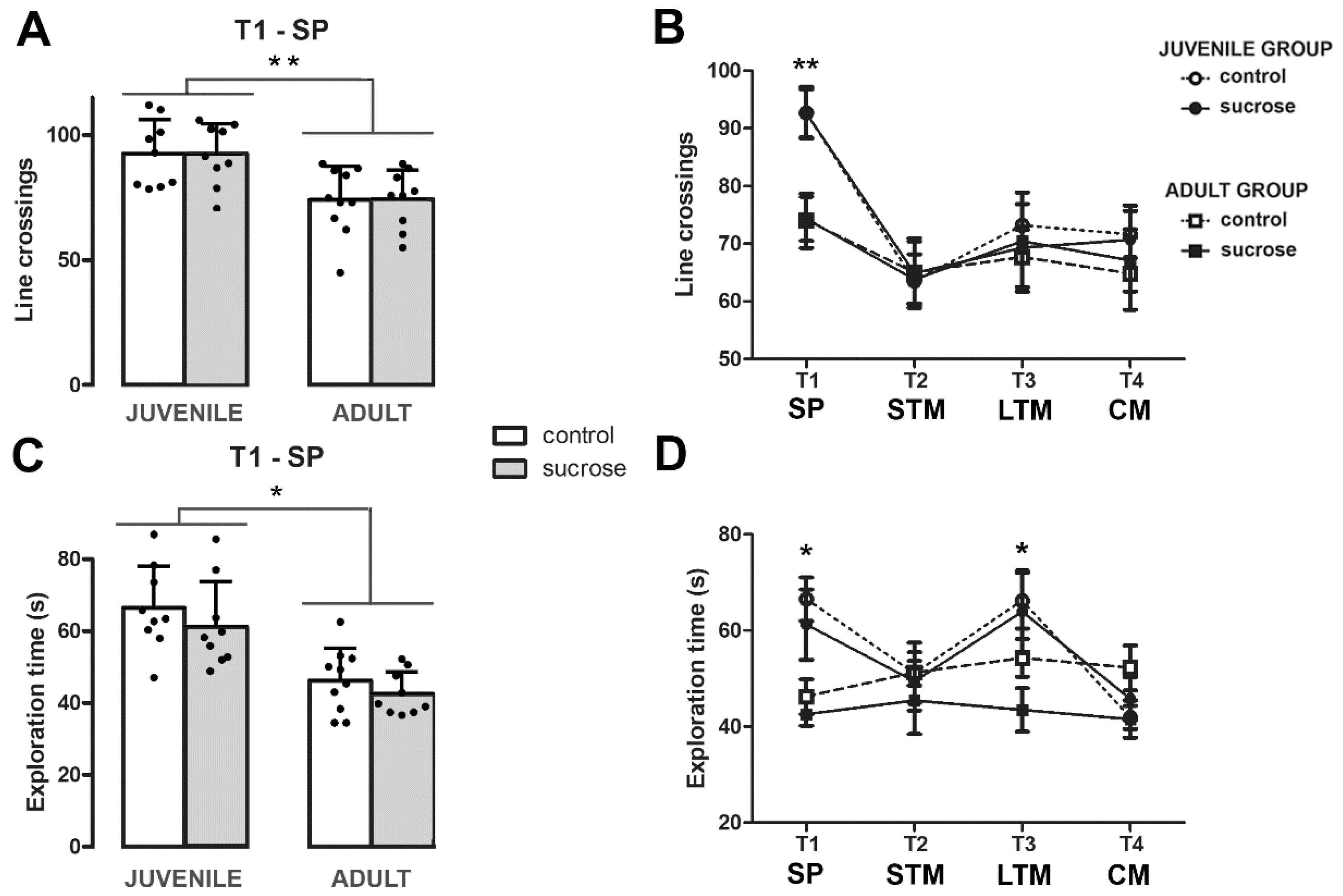
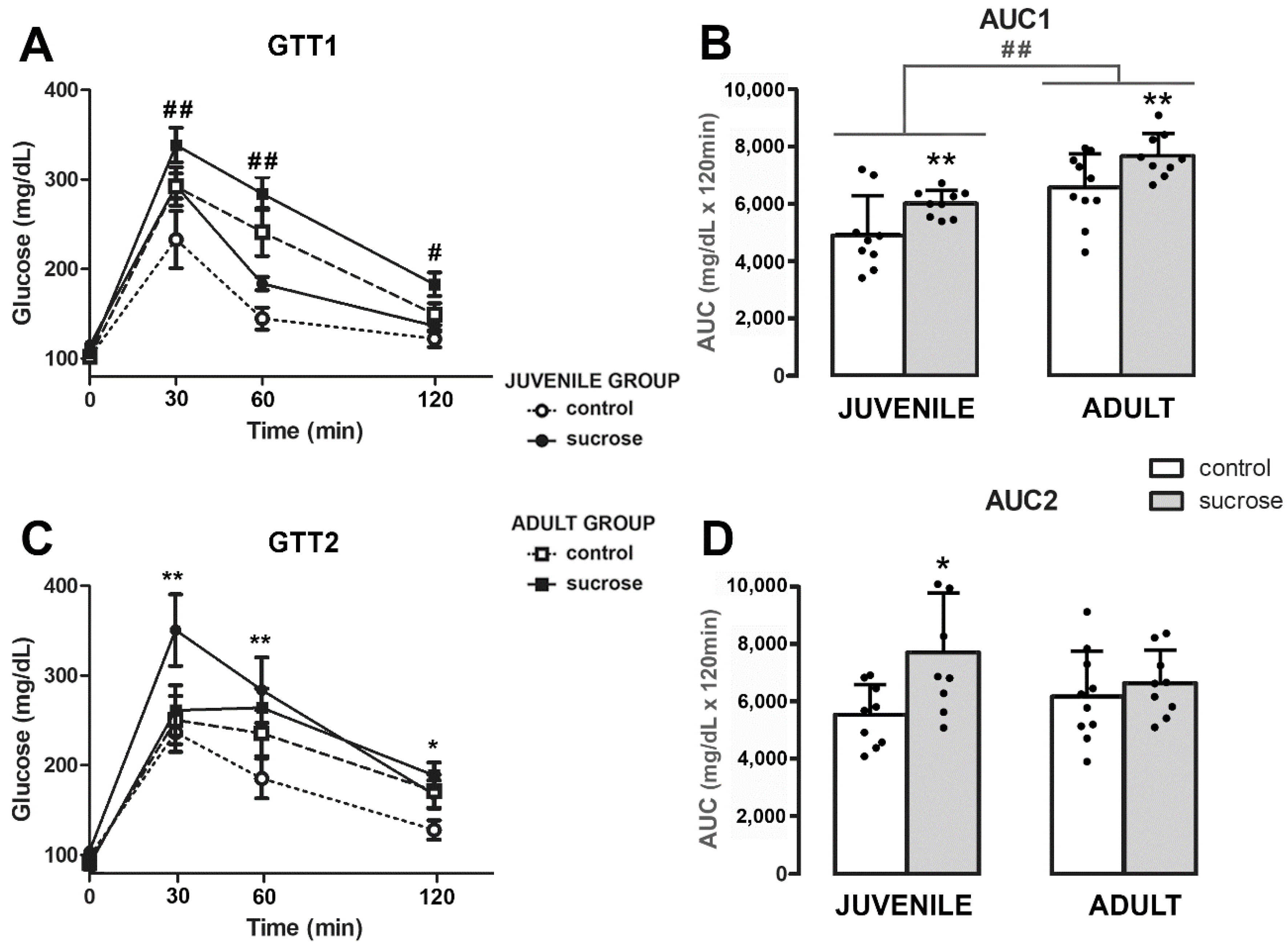
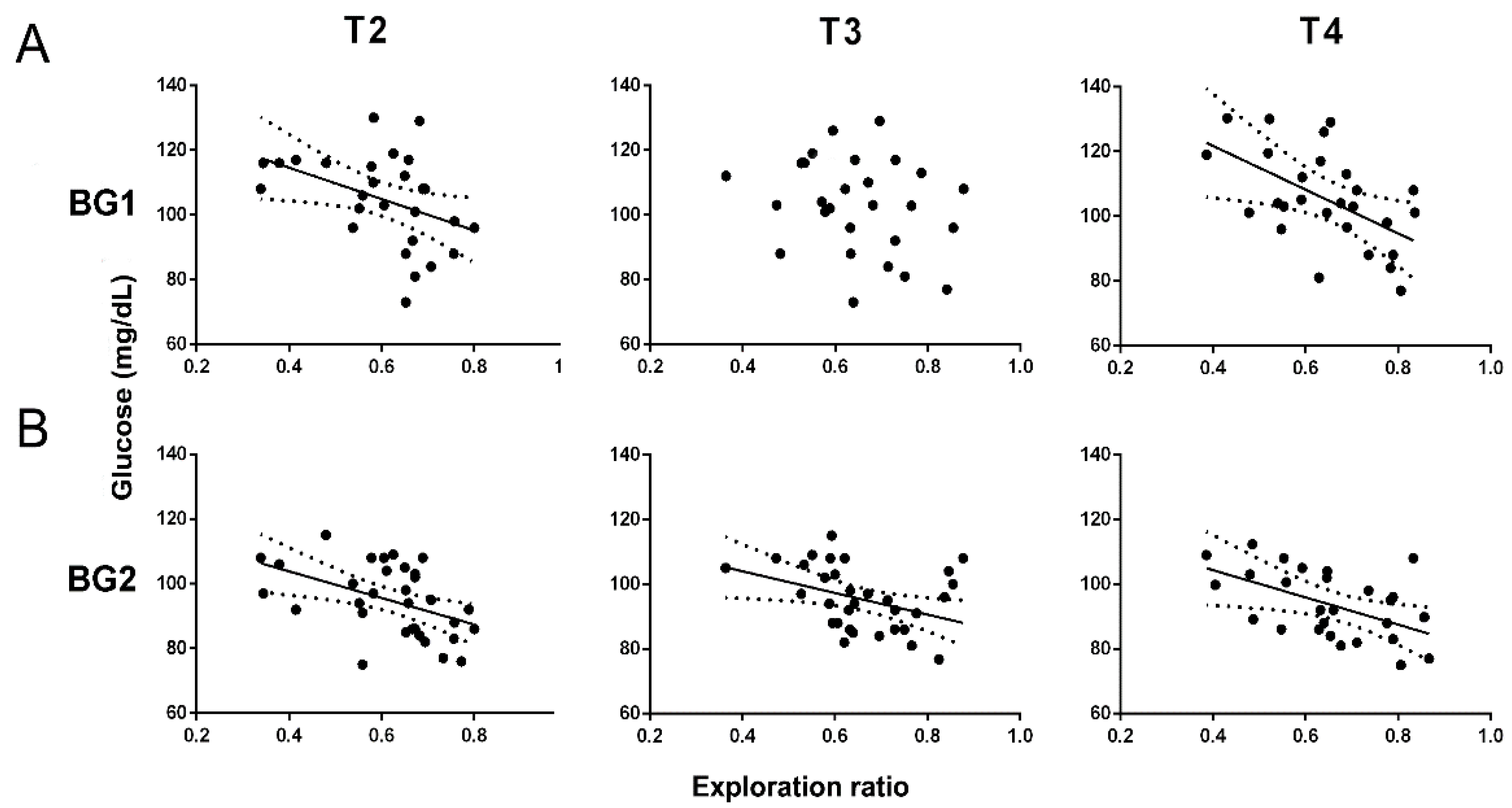
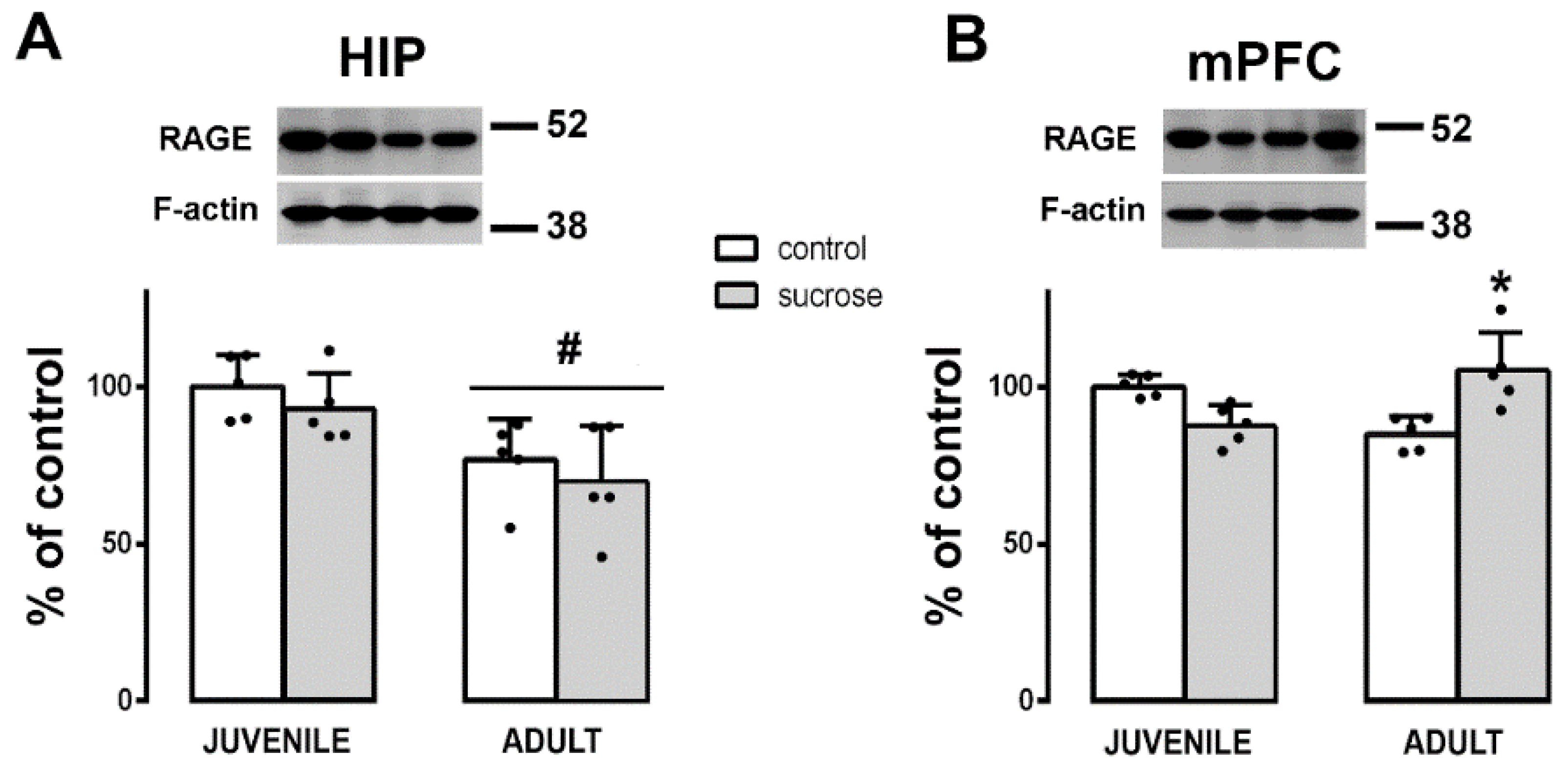
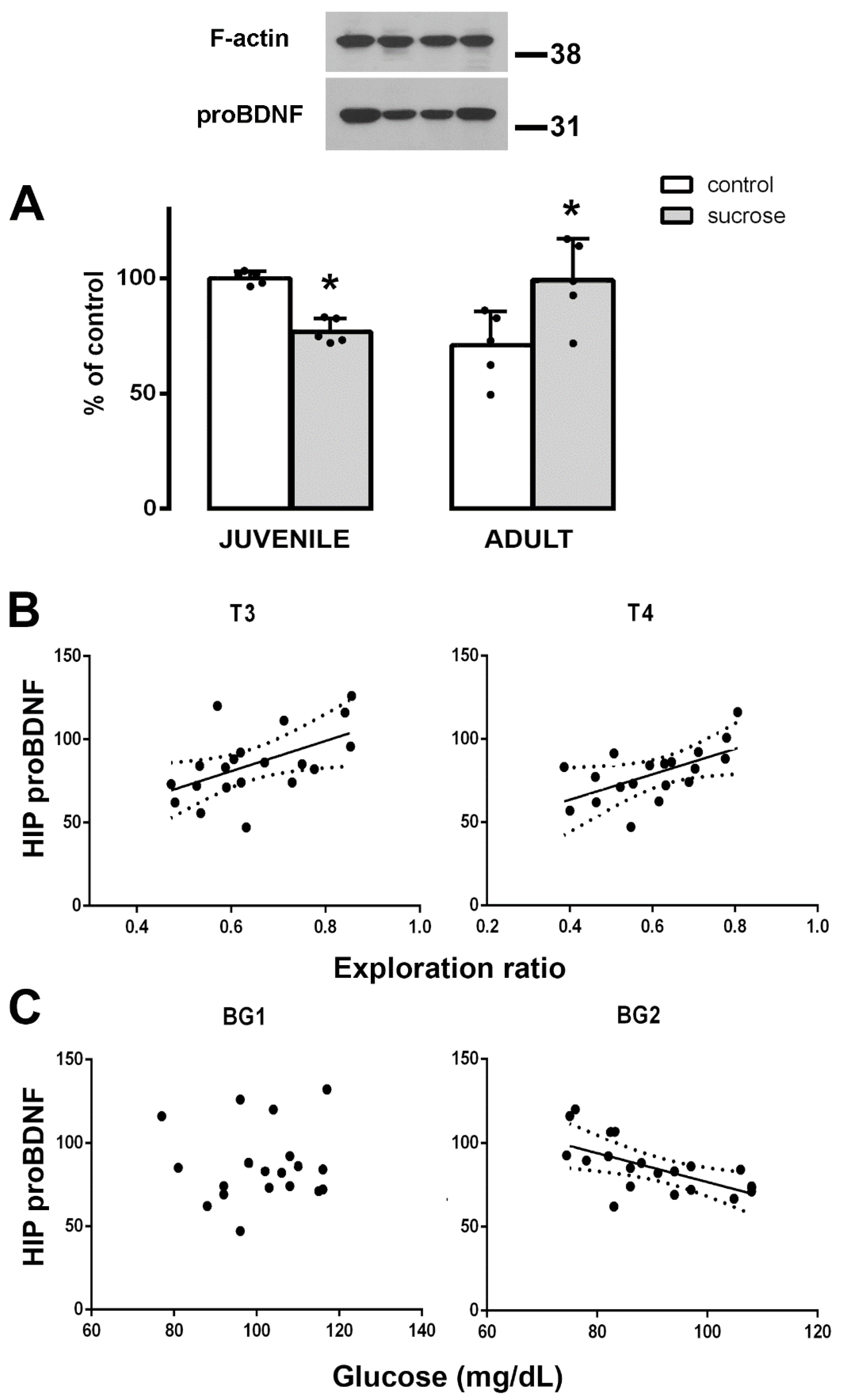
| Juvenile Group | Adult Group | |||||||
|---|---|---|---|---|---|---|---|---|
| PD50 | PD75 | PD100 | PD125 | |||||
| Control | Sucrose | Control | Sucrose | Control | Sucrose | Control | Sucrose | |
| BG (mg/dL) | 101 ± 12 | 115 ± 7 ** | 98 ± 12 | 104 ± 8 | 104 ± 19 | 105 ± 24 | 92 ± 9 | 89 ± 4 |
| TG (mg/L) | 136 ± 40 | 303 ± 103 ** | 117 ± 28 | 116 ± 44 | 127 ± 39 | 259 ± 79 ** | 124 ± 31 | 129 ± 45 |
| COR (ng/mL) | 15 ± 8 | 15± 5 | 14 ± 7 | 23 ± 9 | ||||
Publisher’s Note: MDPI stays neutral with regard to jurisdictional claims in published maps and institutional affiliations. |
© 2022 by the authors. Licensee MDPI, Basel, Switzerland. This article is an open access article distributed under the terms and conditions of the Creative Commons Attribution (CC BY) license (https://creativecommons.org/licenses/by/4.0/).
Share and Cite
Coirini, H.; Rey, M.; Gonzalez Deniselle, M.C.; Kruse, M.S. Long-Term Memory Function Impairments following Sucrose Exposure in Juvenile versus Adult Rats. Biomedicines 2022, 10, 2723. https://doi.org/10.3390/biomedicines10112723
Coirini H, Rey M, Gonzalez Deniselle MC, Kruse MS. Long-Term Memory Function Impairments following Sucrose Exposure in Juvenile versus Adult Rats. Biomedicines. 2022; 10(11):2723. https://doi.org/10.3390/biomedicines10112723
Chicago/Turabian StyleCoirini, Héctor, Mariana Rey, María Claudia Gonzalez Deniselle, and María Sol Kruse. 2022. "Long-Term Memory Function Impairments following Sucrose Exposure in Juvenile versus Adult Rats" Biomedicines 10, no. 11: 2723. https://doi.org/10.3390/biomedicines10112723
APA StyleCoirini, H., Rey, M., Gonzalez Deniselle, M. C., & Kruse, M. S. (2022). Long-Term Memory Function Impairments following Sucrose Exposure in Juvenile versus Adult Rats. Biomedicines, 10(11), 2723. https://doi.org/10.3390/biomedicines10112723







